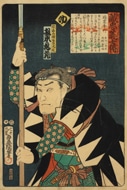The majority of Park West Gallery’s Japanese Woodcut Collection were created during Edo period Japan (1615-1868). Known familiarly as ukiyo-e, or “pictures of the floating world,” this genre of images traditionally portrays “worldly pleasures and earthly delights” – a type of escape that dealt with the frustrating ancient divisions of class between Japanese nobles and warriors.
Historically, many in the warrior class had been able to accumulate vast sums of money, often much more than many of the nobles. But due to strict class definitions, this didn’t matter and they were seen as second tier. Ukiyo-e, or the “floating world,” was born as a place controlled and patroned by the warrior class (and those interested) and it became an area where they could revel in their “earthly delights.” Common forms of entertainment were elaborate tea houses, the company of courtesans and geishas, and the Kabuki Theater.
While many woodcuts depict imagery with geishas, landscapes, and tea houses, the most famous prints portray scenes from the Kabuki Theater. The theater acted out stories deeply engrained in Japanese history – tales that were fantastic, supernatural, mythological, or the aggrandized lives of historical figures. Each story was easily recognized by its audience and the Kabuki actors went to extreme lengths to convey the most dramatic, exaggerated expressions and poses that they could.
At the height of this drama, the actor would freeze, holding a powerful facade. Each actor had his own signature trait, such as how long he would hold his pose, the comedic way his hair was worn, his family crest, or the colors in his costume. Woodblock prints of this period usually depicted specific actors that were recognizable by these signature features.
Likewise, in Kabuki prints, not only were the actors easily recognized, but so too were the stories they acted out. Artists would take the most dramatic pose from an actor’s repertoire and freeze it on a woodblock forever, making sure to include telling marks of who the character was. Having the characters hold something symbolic or depicting them in the midst of their most notorious moments were common ways in which the artist clued the audience in to what was happening.
Finally, Japan resumed trading relations with the United States in 1854 and the rest of Europe by 1868, lifting a 200 year embargo. Japanese prints began populating Europe and the United States and quickly became a novelty. Renowned 19th century artists like Henri de Toulouse-Lautrec, Edgar Degas, James Whistler, and Vincent van Gogh became known collectors of these prints, often bringing aspects of the woodblock style into their own artwork. From the use of sharp perspective, line, and color, to the study of the middle class’s entertainment, without ukiyo-e, 19th century art would have become something else entirely.
The Park West Gallery collection of Japanese woodcuts includes prints by many early modern Japanese artists, including: Kogyo, Kunichika, Toyokuni III, Nishimura Hodo, Toshihide, Toshikata, Kunishige, Chikanobu, Sugakudo, Hosai, Kiyotada, Kunisada III, Gekko, Yoshitaki, Suikuni, Toyokuni I, Nobusui and Kiyosada.




